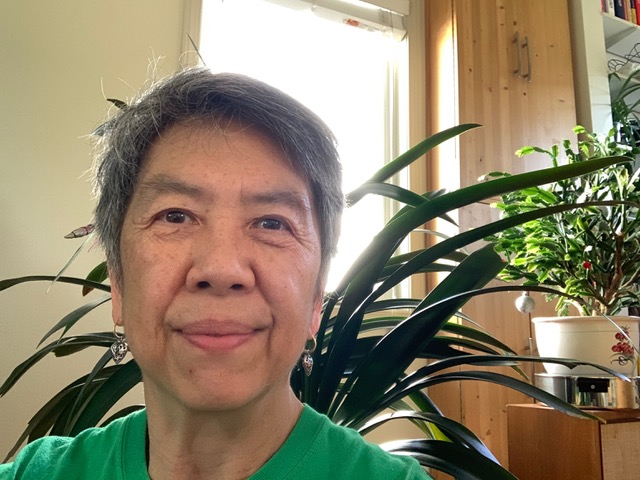By Susan Quan
Originally published in Yoga Bridge - SPRING 2024 VOLUME 25 ISSUE 2
Spring is upon us with longer days and stronger sunshine bringing light and warmth that stimulates the energies of renewal and growth. The change of seasons creates change in our bodies. Balancing these changes for good health is an important focus of Ayurveda, a sister science of Yoga that translates into English as the Science of Life. Ayurveda is regarded as the “Mother of Healing” and is a system of natural healing with spiritual roots from the ancient Vedas.
Ayurveda has multiple treatment protocols. A common underlying theme is to work with the Doshas by balancing their interactions for good health, steady mind and spiritual endeavors through all practices of Yoga and Meditation. What are the doshas? Ayurveda is based on the theory that the entire universe and everything in it is born of the Five Great Elements: Ether (Space); Air; Fire; Water; and Earth. It is the combination of these elements that gives rise to doshas that are responsible for our physical and mental health. Ether (Space) and Air results in Vata Dosha; Fire and Water forms Pitta Dosha while Water and Earth create Kapha Dosha. These three Doshas are the energy forces underlying all of life. They each have their own unique qualities and effects.
It is easier to relate to the Doshas from an individual perspective rather than trying to understand them at a cosmic level. Vata, Pitta and Kapha Doshas underly our physical, mental, emotional and spiritual states. This article will focus primarily on Kapha and Pitta doshas and their influences on us because they pertain to Spring and Summer, respectively.
Spring is Kapha season, and Kapha is most dominant in early Spring. After that, it starts to slowly taper off from mid to late Spring as Pitta Dosha starts to emerge more. Kapha has characteristics indicative of its earthy and watery elements. It is heavy, cold, damp, moist, stable, dense, smooth, soft and cloudy.
Kapha Dosha is responsible for structure, strength, tone and lubrication. It expresses as: muscle, fat, marrow; plasma and reproductive fluids and tissue; flexibility in the body; interconnections of the body’s cells, tissues and organs; mucus, mucosal linings; bodily and synovial fluids; endurance, stamina; and the immune system.
When Kapha is balanced, it gives us calmness, groundedness, centredness, happiness, caring and nurturing, vitality, growth, generosity, kindness and appreciation. When Kapha is unbalanced or aggravated, we can experience sinus congestion, phlegm, colds, lung issues, cold hands and feet, cravings for sweet tasting foods, sluggishness, lethargy, sleepiness, attachment, disinterest and even melancholy (the “blues” or depression).
Aggravated Kapha is counterbalanced by movement and activity i.e. bringing in a bit more of Pitta Dosha’s heat and energy. Here are a few ideas on how (considering your own ability and capacity): active exercise; brisk walks or jogs outdoors; standing and heart opening asanas; sun salutations; and practice your personal form of joyful Warrior 1-3 vinyasa. Massage can also be supportive–it improves circulation of blood and lymph, removes toxins, is nurturing and calms the body and mind.
A gentle pranayama practice is very helpful to counter excessive Kapha. Subtle energy raised through breathing practices is dynamic and can have marked effects even if the strong practices of Kapalabhati or Bhastrika pranayama are not undertaken.
Try some gentle but effective exercises, like a few rounds of Nadi Shodana (refer to https:// artoflivingretreatcenter.org/blog/a-breathing- practice-to-calm-soothe-relax/). Following that, re in easy natural breath and see how you feel. If all is good, then try a few rounds of Surya Bhedana (refer to https://www.prana-sutra.com/post/ surya-bhedana-pranayama-right-nostril-breathing). This practice brings in Pitta’s heat, energy and dynamism since it focuses on breathing in through the right nostril, the surya channel, to work on Kapha. Bring the practice to a close with a few rounds of Nadi Shodana to balance out the system. Rest in easy natural breath.
Experiment with food by adding warm spices (cinnamon, ginger, cloves, garlic, chilies, anise). Warm meals and beverages help to balance excess Kapha while those that are cool or cold such as raw salads, chilled smoothies or iced tea can aggravate it. See what happens when sweet, sour and salty (tastes that Kapha likes but that increases its effect) are replaced with these that reduce it–pungent (spicy), bitter and astringent (drying) tastes. These are only a few general suggestions as food in Ayurveda is a huge topic; many books are solely dedicated to the Ayurvedic characteristics of food and its preparation.
The cycle of the three Doshas operates in all seasons according to the changes in sunlight and weather. As Spring progresses towards Summer, the heat, drive and energy of summer ramps up changes that you may notice in your body, thoughts, attitudes and yoga practice that are different from Spring. Summer is Pitta time.
Pitta Dosha reflects its elements of fire and water. It is intense, hot, fiery, quick, sharp, light, slightly wet, mobile, flowing, subtle, clear and smooth. It oversees digestion, metabolism, temperature regulation, hunger, thirst and blood. It governs digestion, processing of foods and sensory intake by the senses, and creation of metabolic waste. Pitta gives skin, bile, stool and blood their colors.
Balanced Pitta is reflected through good circulation, hearty appetite and strong digestion. One is motivated, enthusiastic, active, intelligent, perceptive, discerning, sharp and is a natural leader.
Pitta overheats with Summer’s intense heat and light. The signs of aggravation are: inflammation, skin rashes and irritation; excessive thirst and excessive appetite; over-heating; quick temper; heart burn; fever; diarrhea; reflexive emotions including anger, rage, intolerance, and frustration; an argumentative, overly assertive or aggressive stance; and lack of concentration and good judgement.
The flames of excessive Pitta are attended to, figuratively speaking, by putting some water on it—not cold water but warm to lukewarm. Why? Quickly dousing Pitta is not healthy as it is vital for our functioning. Here are some tips on gently tempering the excess. Undertake physically demanding activities, especially outdoor ones, during the coolest part of the early morning or in the evening. Swim or immerse yourself in water during the coolest hours. Wear light breathable clothing and a hat. Stay in the shade when outdoors or seek air conditioning. Hydrate often with lukewarm to warm, not cold liquids, and self- massage with coconut oil.
Sweet, bitter and astringent foods cool Pitta while sour, salty and pungent increase it. Notice any effects when chili peppers, cayenne, onion, garlic, cloves, fenugreek, ketchup, mustard, ginger, pepper and mustard seeds are replaced with fresh herbs such as mint, basil, coriander and parsley. Although it is very refreshing to have an ice cold mochaccino or gelato on a hot summer day, observe the overall effects: Is there an immediate cool down in the body after a few sips? Frozen throat? Brain freeze? Drastic temperature change has just occurred in the body and its energetics. It is more beneficial to have eaten or drunk something not so cold. As for Kapha, these are only a few general suggestions drawn from Ayurveda’s vast knowledge base.
Yoga asanas that cultivate an inward, receptive and calm attitude pacify excess Pitta. Explore poses inquisitively. Let the mobility, organic fluidity and subtlety of Pitta express the body’s movements into and creation of its own transformative shapes. Experience Pitta’s shape shifting qualities through movements such as balasana into rabbit (sasangasana) followed by undulating baby cobra onto the elbows to crocodile followed by other intuitive expressions of the body. Substitute sun salutations with those of the moon. Invoke the influence of grounding Kapha dosha with a restorative practice and pranayama such as Sitali and Sitkari. A Chandra Bhedana practice (refer to https://www. prana-sutra.com/post/chandra- bhedana-pranayama-left-nostril- breathing) soothes excess Pitta. It has similar effects on cooling excess heat in Pitta as Surya Bhedana does for raising warmth when Kapha is unbalanced.
In late summer, Vata dosha starts to increase as Autumn is around the corner. Vata is drying, cold, light, hard, rough, clear, subtle and mobile. You may begin to notice a slight chill in the evenings or early mornings, become ungrounded or be mired with an influx of many thoughts more often than usual. Keeping warm and being grounded are keys to balancing this aggravated Vata state. There are several ways to approach balance. Take warm foods and beverages. Walking meditation outdoors helps to immerse the senses and ground your whole being in nature. Keep an inward focus and attention on your yoga practice; perhaps voice or silently contemplate a soothing mantra such as SHRIM (also calms Pitta) and do a few rounds of Nadi Shodana followed by relaxation and a centering meditation. Foot massages are also pleasurable and balancing.
Our circadian rhythms are the dance of life, endlessly shifting through the three Doshas. Notice which Dosha is leading this dance and when it is time for you to take the lead to keep the dance flowing smoothly and in tune. The key to good health for wellness on all levels of our being incorporates the Doshas and goes a step further to recognize we are even beyond the Doshas and the elements from which they are formed–we are in fact pure Awareness- Consciousness.
Ayurveda, like Yoga, is a lifelong sadhana. These two aspects from the ancient Vedas work in tandem, and when practiced with mindfulness, guide us to realizing what we really are–Pure Awareness, or True Nature. Just Now. Just Here. Just Being. OM shanti shanti shanti
Susan Quan is a YAA Certified Senior Teacher, a Yoga and Ayurveda Educator, Reiki teacher and Integrative Chakra Therapy practitioner. Her focus is the art of subtle energy work and “Just Being”. Her contact information is available at https://yoga.ca/teacher-directory.
Susan will be leading a Professional Development Series Webinar on May 16, 2024.

